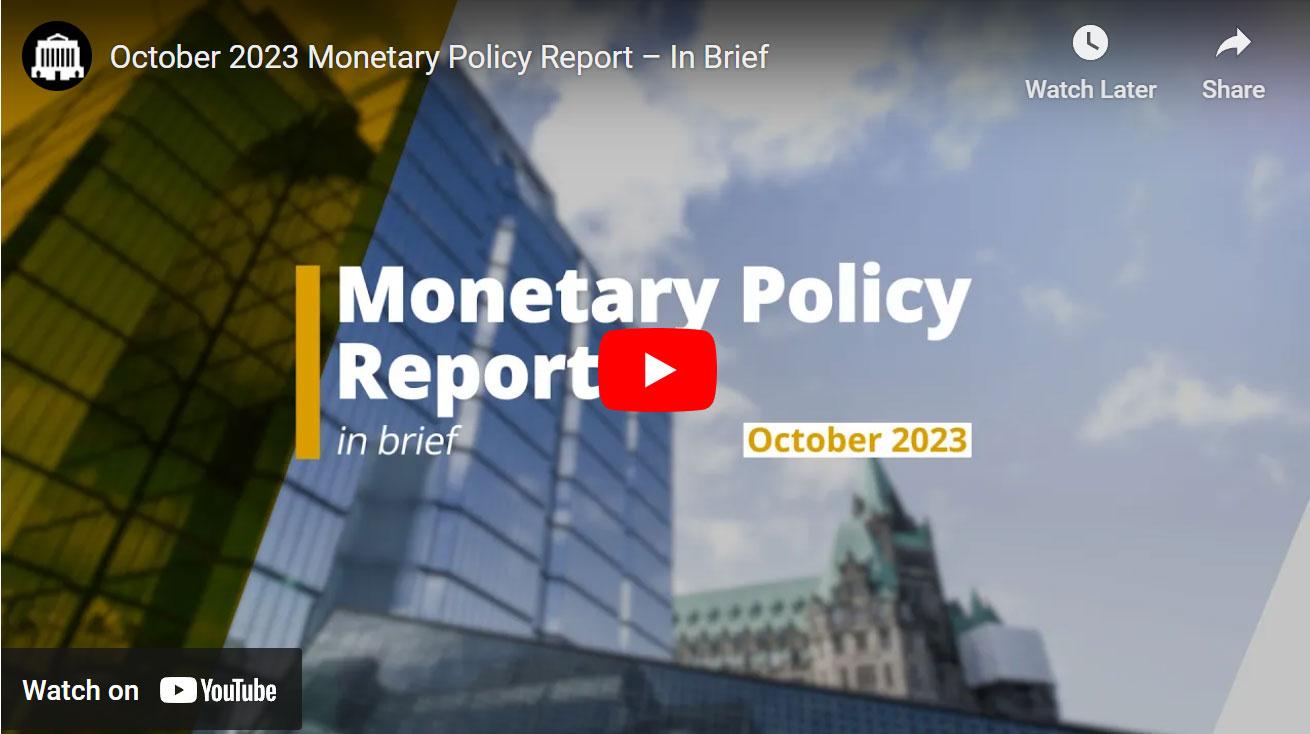
Monetary policy
Canadian economic growth slowed significantly in 2023 as the effects of interest rate increases continued to work their way through the economy. Although inflation was still above the Bank of Canada’s 2% inflation-control target at the end of the year, monetary policy tightening in Canada and abroad had slowed demand and started to ease price pressures.
Inflation in the consumer price index declined significantly from its June 2022 peak of 8.1% to reach 3.4% by the end of 2023. Despite substantial monetary policy tightening, progress toward the inflation-control target has been slower than anticipated.
The Bank raised its policy rate three times in 2023 for a total increase of 75 basis points. This brought the policy interest rate to 5% by July. From then on, Governing Council kept rates unchanged as it monitored signs that past rate increases were having the desired effects of bringing demand and supply into better balance and easing inflationary pressures.
The Bank used a variety of channels to communicate that it:
- would continue to assess whether the current policy interest rate would be sufficient to achieve the 2% inflation-control target
- was prepared to raise the policy interest rate further should inflationary pressures persist
- was carefully weighing the risks associated with both under- and over-tightening of monetary policy
Throughout 2023, the Bank continued its quantitative tightening (QT) as part of normalizing its balance sheet.
Monitoring inflation in the consumer price index
Over the course of 2023, evidence grew that the Bank’s monetary policy was working. Inflation, which had been at 5.9% in January, fell to 2.8% by June. Although it briefly climbed back up to 4% in autumn, it eased to 3.4% by the end of the year. Despite this progress, inflation remained above the Bank’s target throughout 2023.
Low energy prices drove much of the easing in inflation during the first half of 2023. Inflation in the prices of food and many other goods and services also showed signs of easing, as input costs decreased and demand began to slow. However, shelter price inflation remained high, mostly due to the rising costs of mortgage interest and rent. Overall, progress toward the Bank’s inflation target was slower than expected.
Business and consumer expectations for near-term inflation also continued to ease in 2023, but they remained both higher than before the start of the COVID‑19 pandemic and higher than the Bank’s forecast for inflation. Bank survey results indicated that consumers and businesses expected inflation to be above the 2% target for the next two years. Expectations for longer-term inflation remained consistent with the 2% target. Results also revealed that businesses have continued to increase prices more than usual, indicating that corporate pricing behaviour has yet to normalize.
Implementing monetary policy and managing the Bank’s balance sheet
The Bank, like many of its central bank peers, used a variety of tools to address high inflation and manage its balance sheet. These include increases to its policy interest rate and QT, which began in 2022 and continued through 2023. With QT, the Bank no longer replaces maturing Government of Canada bonds on its balance sheet. As a result, the size of the Bank’s balance sheet continued to decline, from $410.7 billion at the end of 2022 to $316.8 billion at the end of 2023.
As well, the Bank began to assess its operational framework for implementing monetary policy and managing its balance sheet in anticipation of the new steady state. This work involved estimating the ultimate range and day-to-day management of settlement balances and offsetting assets, as well as reviewing the Bank’s tools for market operations and asset acquisition.
This follows the Bank’s 2022 announcement that it would implement monetary policy using a floor system—where the interest rate on the overnight deposit facility is equal to the target for the overnight rate. In 2023, the Bank further explained its rationale for maintaining this system.1 It also provided some estimates for the steady-state range of settlement balances and the expected duration of QT.2
ICYMI: In her speech at the @UofRegina, Deputy Governor Kozicki discusses how and why we consider household differences when making policy decisions.https://t.co/2cUK2HQUI7#cdnecon #economy pic.twitter.com/Xahzn3HSnl
— Bank of Canada (@bankofcanada) September 20, 2023
Rebalancing supply and demand
Gross domestic product grew solidly by 2.6% at the start of the year. However, economic growth stalled through the middle of 2023. The softening in demand was most visible in sectors that are sensitive to interest rates. For example:
- the housing market continued to slow
- consumer spending softened
- per capita consumption fell even though solid population growth continued to support overall spending
With slowing demand growth and rising supply, an increasing number of indicators suggested that the economy was in balance in the second half of the year.
Supporting the Bank’s monetary policy function
Despite the highly complex forces affecting supply and demand, the Bank’s forecasts correctly anticipated that in 2023:
- Canadian and global growth would slow
- inflation would fall significantly from the peaks observed in 2022
| Achievement of target for consumer price index (CPI) inflation | ||||||||
| Key indicators | Reference level | 2017 | 2018 | 2019 | 2020 | 2021 | 2022 | 2023 |
| CPI inflation (%) | 2.0 | 1.6 | 2.3 | 1.9 | 0.7 | 3.4 | 6.8 | 3.9 |
| Average CPI inflation since 2001 (%) | 2.2 | |||||||
| Inflation expectations at a 10-year horizon (%) | 2.0 | 2.0 | 2.0 | 2.0 | 2.0 | 2.0 | 2.0 | 2.0 |
Analyzing inflationary pressures and the transmission of monetary policy
In 2023, the Bank continued its extensive analysis of inflationary pressures. As always, its macroeconomic models were essential in this work. Staff explored, among other topics:
- the supply side of the economy
- the role of structural changes in labour markets and immigration
- input costs and food prices
- supply-chain disruptions and near-shoring3
- the effects of pricing behaviour and markups on inflation4, 5
- the recent challenges faced by central banks in forecasting inflation6
Meanwhile, the Bank’s consumer and business surveys continued to provide key information about Canadians’ evolving expectations for inflation. As well, Bank staff engaged with outside experts on these topics.
The Bank also worked to better understand the effects of higher interest rates. It used its macroeconomic models, as well as detailed Canadian mortgage data, to capture the implications for mortgage interest costs and consumer spending. As well, it enhanced and updated its framework for assessing the health of the Canadian labour market and used microdata to better understand labour market dynamics.7, 8
Inflation dynamics in the rest of the world have been similar to those observed in Canada. Drawing lessons from a range of countries’ experiences, the Bank analyzed the roles that monetary policy, inflation expectations and easing supply constraints play in the process of global disinflation.
Integrating a variety of data points to strengthen analysis
Given the high level of economic uncertainty during 2023, the Bank actively sought out new data and information sources to strengthen its analysis. These efforts included:
- enhancing the Bank’s business and consumer surveys and making use of insights from its Market Participants Survey, the results of which were published for the first time in February 2023 following a successful pilot
- applying innovative approaches to non-traditional data, such as using textual analysis of news reports to track layoffs in real time and aggregating firm-level job postings to monitor vacancies by industry
- reviewing market intelligence practices to ensure the Bank is maximizing its engagement with stakeholders in financial markets
- exploring how valuation ratios in the Canadian stock market can help reveal investors’ expectations about future economic growth
- developing a new analytical model that combines macroeconomic and financial market variables to estimate probabilities of various growth and inflation outcomes
Bank staff also explored research and data related to Indigenous economies in Canada and continued to examine how monetary policy affects them.9 Such analysis gives the Bank a clearer picture of the different ways its actions affect various groups.
Assessing the implications of structural changes to the economy
Staff continue to investigate what structural changes mean to the economy—both in Canada and around the world. Research and analysis on their implications provide another input into the Bank’s decision-making and monetary policy actions.
In 2023, this work included a variety of research on the implications of the surge in population that began in 2022.10 Staff also explored the roles that digitalization, automation and the adoption of advanced technologies play in the Canadian economy. Notably, staff examined the implications of digitalization for labour markets, productivity, prices and monetary policy.
The effects of climate change are also an important driver of structural change. The Bank continued to integrate climate considerations into its research and analysis. This included developing an enhanced and expanded set of modelling tools for assessing the effects of climate change and the transition to a low-carbon economy. The Bank integrated the impact of green investment tax credits into its projection of business investment. In addition, staff analyzed the adverse effects of climate disruptions on international trade.11
Looking forward
In 2024, the Bank will continue to assess how higher interest rates affect inflation and the broader economy. In addition, the Bank will:
- adapt its balance sheet management and market operations to support the anticipated steady state
- continue to improve its macroeconomic models, including the ongoing development of a new suite of models to produce more accurate projections and better enable a risk management approach to monetary policy
- deepen its understanding of inflation drivers, including labour market tightness and wage developments
- enhance its surveys and outreach as well as the tools it uses to understand what structural changes mean for monetary policy and the economy
- publish its Indigenous Reconciliation Action Plan
- initiate a review of its COVID-19 pandemic response
- plan for the 2026 renewal of its monetary policy framework
More information
Framework for market operations and liquidity provision
Canadian Survey of Consumer Expectations
“Ending the pain of high inflation” (remarks by Governor Tiff Macklem)
“Understanding the unusual: How firms set prices during periods of high inflation” (remarks by Deputy Governor Nicolas Vincent)
“Rebalancing the economy while managing risks” (remarks by Deputy Governor Sharon Kozicki)
- 1. T. Gravelle, R. Morrow and J. Witmer, “Reviewing Canada’s Monetary Policy Implementation System: Does the Evolving Environment Support Maintaining a Floor System?” Bank of Canada Staff Working Paper No. 2023-10 (May 2023).[←]
- 2. T. Gravelle, “The Bank of Canada’s market liquidity programs: Lessons from a pandemic” (remarks to the National Bank Financial Services Conference, Montréal, Quebec, March 29, 2023).[←]
- 3. S. Kabaca and K. Tuzcuoglu, “Supply Drivers of US Inflation Since the COVID‑19 Pandemic,” Bank of Canada Staff Working Paper No. 2023-19 (March 2023); O. Kryvtsov, J. C. MacGee and L. Uzeda, “The 2021–22 Surge in Inflation,” Bank of Canada Staff Discussion Paper No. 2023-3 (January 2023).[←]
- 4. R. Asghar, J. Fudurich and J. Voll, “Firms’ inflation expectations and price-setting behaviour in Canada: Evidence from a business survey,” Bank of Canada Staff Analytical Note No. 2023-3 (February 2023).[←]
- 5. P. Bouras, C. Bustamante, X. Guo and J. Short, “The contribution of firm profits to the recent rise in inflation,” Bank of Canada Staff Analytical Note No. 2023-12 (August 2023).[←]
- 6. C. Conces Binder and R. Sekkel, “Central Bank Forecasting: A Survey,” Bank of Canada Staff Working Paper No. 2023-18 (March 2023).[←]
- 7. S. Birinci, F. Karahan, Y. Mercan and K. See, “Labour Market Shocks and Monetary Policy,” Bank of Canada Staff Working Paper No. 2023-52 (October 2023); S. Birinci, Y. Park, T. Pugh and K. See, “Uncovering the Differences Among Displaced Workers: Evidence from Canadian Job Separation Records,” Bank of Canada Staff Working Paper No. 2023-55 (October 2023); L. Shao, F. Sohail and E. Yurdagul, “Labour Supply and Firm Size,” Bank of Canada Staff Working Paper No. 2023-47 (August 2023).[←]
- 8. E. Ens, K. See and C. Luu, “Benchmarks for assessing labour market health: 2023 update,” Bank of Canada Staff Analytical Note No. 2023-7 (May 2023).[←]
- 9. A. Chernoff and C. Cheung, “An Overview of the Indigenous Economy in Canada,” Bank of Canada Staff Discussion Paper No. 2023‑25 (October 2023).[←]
- 10. T. Gravelle, “Economic progress report: Immigration, housing and the outlook for inflation,” (speech to the Windsor–Essex Regional Chamber of Commerce, Windsor, Ontario, December 7, 2023).[←]
- 11. G. R. Dunbar, W. Steingress and B. Tomlin, “Climate Variability and International Trade,” Bank of Canada Staff Working Paper No. 2023‑8 (January 2023).[←]


